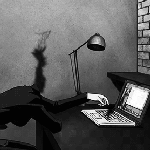|
You've probably heard these figures before: 90% of all silent films are lost. 50% of all films made before 1950 are lost. Why are films lost? Why do films decay? Why does it matter? Before going into anything, there's a great documentary from the 1990s called Keepers of the Frame. It goes into preservation, what problems film face, and why it's important. https://www.youtube.com/watch?v=ytt1eehq_jI What is the difference between restoration and preservation? The idea behind restoring a film is to bring it back to as close as its original presentation as possible. It could entail mostly editorial work, such as re-inserting footage previously omitted. Or damaged reels are carefully cleaned using hand work or digital processes. The vast majority of restorations are routine. You're simply cleaning up decades of wear and tear. Others may take years of work because of a myriad of problems. Preservation is about survival. You want multiple copies with confirmed optimal quality. Original camera negatives are the best starting point because it's usually what went through the camera. It's not always possible. There's also fine-grain positives (B&W) or interpositives (color), which are highly detailed copies made from original negatives meant for duplication. There's also color separations, where color is converted to three sets of high quality fine-grain positives gone through filters. Black and white film never fades. What sort of problems can films have? Prior to the early 1950s, nearly all films were shot using cellulose nitrate stock. While it was an extremely high quality base for film, it was extremely flammable. Even brand new film could ignite and burn. Worse, when nitrate film decomposes, it becomes more flammable and can spontaneously combust. However, nitrate is also a very stable base when carefully preserved at low temperatures and low humidity. The original nitrate camera negative to The Great Train Robbery, made in 1903, still exists in the Library of Congress archive. Other films like Snow White and the Seven Dwarfs, The Wizard of Oz, and Mr. Hulot's Holiday all have intact nitrate negatives. Here's what burning nitrate film looks like: https://www.youtube.com/watch?v=AL9izOFrqbw The industry switched to acetate "safety" film by the early 1950s. Completely non-flammable. Studios copied their nitrate (some thoughtfully, others cheaply) to safety film. However, instead of burning up when poorly preserved, it eventually melts into goo and lets out eye-burning fumes. This is called vinegar syndrome. There's also the problem with color. Technicolor films, known for their vibrancy, were shot on B&W film. The camera would expose three strips of B&W films shot through filters. That's one reason why almost all Technicolor feature-length films survive with mostly intact camera negatives. With exceptions. By the mid-1950s, Technicolor was phased out in favor of Eastmancolor film. A single strip of film with three layers of emulsion. However, while B&W never fades, Eastmancolor does. It's mainly due to B&W utilizing metal-based emulsion, while Eastmancolor used organic-based dyes. While most Eastmancolor prints, even from the early 1980s are faded beyond use, Technicolor prints from as far back as the 1930s are still retaining 99% of their color.  35mm frame from 2001: A Space Odyssey(1968)  Blu-Ray screenshot from The Adventures of Robin Hood (1938) Besides the switching of formats, the way films were duplicated caused problems. Until the early 1980s, nearly all films were duplicated from camera negatives. This meant that a negative could undergo extreme wear and tear, more than the film stock was meant to take. One example would be Rear Window, which had almost 400 prints made from its negative just in 1954. Star Wars, the original 1977 film, also had an unusually high print run, which made its negative all but unusable by the early 1990s. Now, restoration is more about digital work. The truth is that a lot of films touted as "fully restored" had mostly just routine maintenance in the digital world, such as dirt/scratch cleanup and color timing. Nothing in common with films like Lawrence of Arabia, Spartacus, The Godfather, or even Manos: The Hands of Fate which were more resurrected than restored. I'll leave the discussion open more and add onto this with more detailed content. Restoration and preservation has been a field I've researched a lot, so feel free to ask about stuff. Anyone else well-versed is welcomed to join in, too.  Comparison of before/after frames from the 4K digital restoration of Jaws (1975) The thread title is taken from the restoration documentary on The Godfather on Blu-Ray and worth seeing
|
|
|
|

|
| # ? May 3, 2024 07:50 |
|
Egbert Souse posted:The industry switched to acetate "safety" film by the early 1950s. Completely non-flammable. Studios copied their nitrate (some thoughtfully, others cheaply) to safety film. However, instead of burning up when poorly preserved, it eventually melts into goo and lets out eye-burning fumes. This is called vinegar syndrome. There's also the problem with color. Technicolor films, known for their vibrancy, were shot on B&W film. The camera would expose three strips of B&W films shot through filters. That's one reason why almost all Technicolor feature-length films survive with mostly intact camera negatives. With exceptions. By the mid-1950s, Technicolor was phased out in favor of Eastmancolor film. A single strip of film with three layers of emulsion. However, while B&W never fades, Eastmancolor does. It's mainly due to B&W utilizing metal-based emulsion, while Eastmancolor used organic-based dyes. While most Eastmancolor prints, even from the early 1980s are faded beyond use, Technicolor prints from as far back as the 1930s are still retaining 99% of their color. Was Eastmancolor the reason why all the film prints from the 70's turned brown? I've always assumed the the filmstock was the problem with the films at that time, but I had assumed that they must have switched to something around then since there's this period of roughly ten or twelve years where films just seemed to go yellow and brown. The color films of the fifties and sixties seems to have faded in a completely different way to my eyes.
|
|
|
|
i know roughly zip about film preservation but find it very interesting so i just wanna say: great OP, great theead title.
|
|
|
|
Uncle Boogeyman posted:i know roughly zip about film preservation but find it very interesting so i just wanna say: great OP, great theead title. I find the technical aspects of filmmaking really fascinating, so this sort of stuff is right up my alley. I wonder if Ben Solo would have anything to contribute with regards to his Manos restoration?
|
|
|
|
Random Stranger posted:Was Eastmancolor the reason why all the film prints from the 70's turned brown? I've always assumed the the filmstock was the problem with the films at that time, but I had assumed that they must have switched to something around then since there's this period of roughly ten or twelve years where films just seemed to go yellow and brown. The color films of the fifties and sixties seems to have faded in a completely different way to my eyes. Yes. A lot of early eastmancolor was processed by Technicolor and held up better. But most of it was cheaply processed. Especially Deluxe and Metrocolor. A lot of films shot from 1959 to 1960 were shot on defective stock that faded quicker on negatives. Spartacus and North by Northwest are two examples. They had to digitally restore them by taking the two layers with minimal fading and combine with the yellow color separation to replace the totally faded layer. Very few prints survive with good color though. Even pristine prints deposited with the Library of Congress. The new color stocks for prints started around 1982. Original prints of Return of the Jedi are mostly with intact color, but the prior two probably have none with good color. I have a strip from an original print of Aliens and it looks perfect. And it was stored in a barn for twenty years.
|
|
|
|
One of the things that will be interesting to see is how the switching over to digital will impact preservation of films. While there are still a lot of films being shot on film stock, including big blockbusters like Jurassic World, Mission Impossible, and Star Wars, most films being released today are being shot with digital cameras. And as the industry switches to a new standard, it's definitely a question we have to ask. We can look back to the music industry to see how badly digital media can be preserved. For example, a lot of early digital recordings exist in a tenuous state. Even if the tapes are in good condition, there may only be 1 or 2 players left in the world that can read the information on those tapes and play them back. And when they go, that's it. Those tapes are worthless. Granted, there's already cases where digital recordings aren't in good shape. For example, the Cult's album "Love," which was recorded digitally, has no good multi-tracks remaining. The only usable tape they have only has about 80% of the album on it. Surely, you say, that's an album for the 1980s. They must have gotten better. Maybe not. For example, the multi-track masters to "All Star" by Smash Mouth, another digital recording, are missing tracks. Which means that you couldn't use the song in Rock Band without rerecording tracks. Or if you wanted to remix the song, you wouldn't be able to without rerecording or extracting stuff from the masters. There's other issues that come up. Even if you have a file that can be read by your software, there's no guarantee that it will sound the same as it did. For example, that reverb plug-in you used on the drums might not be around anymore or might not be compatible with the new software. That means while we might have the files, we won't have the effects and edits made to the files. I also read a report that said that digital preservation is 11 times more expensive than analog. Case in point - when they restored Jaws, they struck up a new 35 mm negative copy of the film because it was a known quantity. They could store that in the vaults and know in 20 years that they would have something good to work with.
|
|
|
|
The worst transition was from silent to sound. Studios threw out decades of material (Universal in 1948), others stored poorly (1937 Fox archive fire). And a shocking amount of early sound films were lost. Digital is perfect for exhibition with current technology, but film lasts. Optical sound can be reverse engineered. We still have negatives from the 1920s in good condition. We even found ways to make Cinerama work practically 50 years after the films were made. But I think a lot of films shot on film, but fully edited digitally will eventually need to be reconstructed not unlike what was done with Star Trek: TNG and Seinfeld. One of my college films was shot on MiniDV and edited in FinalCutPro. My final edit survives as a 240p YouTube file with mono sound. The tape will only play back correctly on a MiniDV deck. Another I had to reconstruct, but it was only because the original source video files were accidentally saved on a drive. Otherwise it would exist only as uncut footage.
|
|
|
|
Egbert Souse posted:Restoration and preservation has been a field I've researched a lot, so feel free to ask about stuff. To take an example of a few films I recently realized aren't available on DVD or blu-ray. Inchon and The Lonely Lady (1982 and 1983 winners of the Golden Raspberry Award for Worst Picture). Are negatives from films of that era (and notoriety) being stored in a vault somewhere or do studios sometimes throw out and neglect even more recent releases like this? I read Reagan screened Inchon at the White House. Approximately how much does it cost a studio to take a film from that era and get it restored and transferred to DVD/blu-ray? I guess I'm basically trying to determine if films of that caliber are ever going to get a proper release or if I should just watch the 4x3 versions. I know it's talked a lot about how so many films are lost forever but it seems like there are many that are exceedingly difficult to track down by any means.
|
|
|
|
I don't have anything to contribute, but wanted to also say thanks for the thread. I'm looking forward to reading some good conversation and learning things
|
|
|
|
Zogo posted:To take an example of a few films I recently realized aren't available on DVD or blu-ray. Inchon and The Lonely Lady (1982 and 1983 winners of the Golden Raspberry Award for Worst Picture). Most negatives should be fine, especially from that era. It probably has more to do with a studio not wanting to spend more money on a film that's already a bad loss. There's a lot of perfectly preserved films out there with rights holders having no intention of any of it being utilized. Just for an example, Disney had the camera negatives to Song of the South scanned at 4K resolution years ago as part of their ongoing archival program. As for costs, it's not uncommon for a proper remaster to be in the 50K area for the most basic treatment. Film elements have to be inspected by hand for damage, then transferred. Then cleaned, timed, and encoded. The more complex, the more expensive. The official figures aren't out, but it wouldn't be surprising if Sony spent around $2-3 million on Lawrence of Arabia. The original 65mm camera negative was scanned at 8K (which took around a year), then restored at 4K resolution (another year). However, the hand-retouching was handled by Prasad, an Indian company that specializes in digital cleanup. They also worked on The Red Shoes and Ben-Hur for Warner MPI (Motion Picture Imaging). A lot of important movies have had some really severe problems. Vinegar syndrome claimed the camera negatives to Robert Altman's M*A*S*H and Dr. Strangelove. The first and last camera negative reels of A Hard Day's Night, as well as the entirety of Becket, Cabaret, and The Best Years of Our Lives were lost during shipping. The 1967 MGM Vault fire claimed the camera negatives to most of their short subjects and cartoons, as well as countless silents (including London After Midnight). Fox junked nearly all their nitrate in 1976 after cheaply and quickly copying to safety film. Even the Technicolor ones, which were copied to Eastmancolor instead of B&W separations. The original camera negative to Lawrence of Arabia was kept in a former bowling alley with no climate control for years. On the other hand, most people know about The Passion of Joan of Arc having one surviving original print being found in an asylum. A 16mm duplicate negative of the nearly uncut Metropolis was found in Argentina. The camera negative to The Big Parade was thought lost for years until it turned up at George Eastman House. Or some really neat stuff, Disney's Pollyanna had a neat story. It was shot on that faulty 1959-1960 Kodak stock. When they wanted to restore it, they found out that the negative had almost completely lost its yellow layer. So, they were going to use the color separations. Except when they were made, someone made two of the same color instead of three unique ones. They ended up making a new separation from the faded negative, adjusted the gamma, then combined with the original separations. It worked perfectly.
|
|
|
|
Zogo posted:To take an example of a few films I recently realized aren't available on DVD or blu-ray. Inchon and The Lonely Lady (1982 and 1983 winners of the Golden Raspberry Award for Worst Picture). Oh Inchon. THAT was an interesting story of a film, and it basically turned out to be a big embarrassment for everyone involved. Basically, the Unification Church made a movie about MacArthur, and it turns out to be a big embarrassment for everyone involved. The thing with films like that is there's a lot of complicating factors. So, whoever owns the home video rights may not want to distribute it because it was a huge failure, and frankly, it's not comically bad, it's just really bad, at least from what I've seen. It's also not really well known outside of a few people who actually care, so there's no way to market the film. "Hey, own a film that nobody liked and nobody really remembered." Or, since the Unification Church was involved, the people who could make it happen just don't care enough to make it happen. With films like that, we'll never know exactly why it's unavailable.
|
|
|
|
Egbert Souse posted:Original prints of Return of the Jedi are mostly with intact color, but the prior two probably have none with good color. Isn't Lucas' own Technicolor print -- the one that was used as a reference for color timing for the Special Editions -- thought to be the only intact copy of the original Star Wars?
|
|
|
|
Egbert Souse posted:As for costs, it's not uncommon for a proper remaster to be in the 50K area for the most basic treatment. Film elements have to be inspected by hand for damage, then transferred. Then cleaned, timed, and encoded. The more complex, the more expensive. $50K sounds very affordable and trivial for a studio. I guess I don't know exactly what motivates the restorations/releases. It's safe to assume it's primarily the money but there has to be some judgment calls at times. Cemetry Gator posted:It's also not really well known outside of a few people who actually care, so there's no way to market the film. "Hey, own a film that nobody liked and nobody really remembered." Perhaps the Golden Raspberry awards will have to grow in stature further before we're graced with these films. I hate to do it in 2015 but it appears I'm going to be stuck watching 4x3. Watching a 2.35:1 film in 4x3 is atrocious as you're basically losing 43% of the visual information.
|
|
|
|
Zogo posted:$50K sounds very affordable and trivial for a studio. I guess I don't know exactly what motivates the restorations/releases. It's safe to assume it's primarily the money but there has to be some judgment calls at times. $50K is an average length 16mm or 35mm movie with either few problems or minimal work at 2K resolution. There's a reason why a lot of remasters meant for Blu-Ray are done at 2K - they're not really doing archival work, but rather sticking to a budget. Nothing wrong with that, but a smaller percentage will get the "full treatment." That is a full 4K (or higher) workflow, shots or even frames given editorial work, and 99.99% cleanliness. Think of the mind-boggling 4K restorations coming from Sony Colorworks and Warner MPI. Just for an example, Warner spent around a million to restore North by Northwest. They had to scan the entirety of the faded VistaVision camera negative (likely at 6K resolution), as well as the complete VistaVision B&W yellow color separation. It's like they had to transfer twice as much film. Then, at 4K resolution, they had to merge the two lesser faded layers of the negative with the intact color separation layer. Adjustments on a shot-by-shot basis and likely heavy digital cleanup. Then it's output back to film for preservation. In fact, Warner routinely will output two 35mm negatives - one with a straight raw copy of the negative and another with all the digital cleanup. And there's still all the work that has to be done with sound. While Warner was fortunate to have the soundtrack negative, music/effects track, and original score recordings available, other films aren't as lucky. With Vertigo, literally the only original elements for the sound were a few original 35mm prints. Hitchcock owned the rights to the film and was given bad advice on what to keep. They ended up taking what they could from the print, then completely re-working the sound by re-creating the foley and dropping in most of the 3-track stereo music recordings. If you've heard the track on the Blu-Ray, it sounds incredible (not the obvious foley on the older DVD). I think as a video format matures, rights holders will dig deeper. Niche labels have helped, but few can afford full restorations. And if it's a film with a lot of issues and the label has to pay for stuff the rights holders should, why should they?
|
|
|
|
Great Moments in Film Preservation History: - Since Hal Roach retained ownership of most of his films (i.e. Laurel & Hardy and Our Gang), he had to pay a storage tax on the archival holdings. To avoid this tax, he would have the entire library hauled out on a big truck to the Nevada state line to stay for two days and bring back. In the middle of summer. All nitrate. - Fox decided to copy all of their nitrate to safety film in 1976. This included Technicolor films, which were copied onto color reversal internegative stock. Yes, the same stock that would cause fading problems with Star Wars the following year. Most of the classic Fox Technicolor films exist only as studio prints and these fading internegatives. - Universal decided to junk nearly their entire silent film library in 1948 and had the film stock recycled for its silver content. It's worth noting that even if they had saved it, films like The Hunchback of Notre Dame and The Phantom of the Opera already had nitrate decomposition on their surviving negatives and likely would have had to been destroyed anyways. Universal's silent films have one of the worst survival rates, along with Fox. By contrast, over 600 silent features survive just from MGM's own holdings. - In the late 1950s, MCA TV bought the rights to the 1929-1948 Paramount Pictures library. After copying nitrate originals to safety film masters meant for TV prints, they junked the majority of the elements. Most of these films survive with decent quality only because prints were deposited with UCLA. - Only one Indian silent film is known to exist in its near-entirety. - Most pre-1980 Turkish and Iranian films are lost or survive only in poor quality copies due to political coups. But on a positive note... - The camera negatives to Un chien andalou, The Great Train Robbery, Buster Keaton's The General, M, and The Cabinet of Dr. Caligari still exist in mostly complete form.
|
|
|
|
this stuff is super interesting to read , thanks for sharing (and keep on sharing).
|
|
|
|
I know it was talked about some in another thread (quite possibly by you), but what about the current state and future of Chinese films, particularly kung fu movies? I would love a decent copy of The Master of the Flying Guilottine, 36 chambers of Shaolin and epecially, The Miracle Fighters
|
|
|
|
Dr.Caligari posted:I know it was talked about some in another thread (quite possibly by you), but what about the current state and future of Chinese films, particularly kung fu movies? I would love a decent copy of The Master of the Flying Guilottine, 36 chambers of Shaolin and epecially, The Miracle Fighters Asian cinema is often in pitiful condition. As with most films before the 1980s, most films were duplicated directly from the camera negatives. This is exactly why films like Rashomon and Seven Samurai do not have surviving camera negatives. They were likely duplicated so much that they were worn out. Which happened with a lot of early silent films. Why keep the reels if they're unusable? Of course, now, we're able to do stuff like extract images from films with nitrate decomposition, fire damage, and even serious color fading. Another problem was that Asian cinema didn't have a real archival movement like American and some European countries did. To be honest, the US was more of an exception to the rule. Other countries with great archival practices are Germany and the former Soviet Union. Of course, war didn't exactly help things. This is why a lot of Asian films have really bizarre survival conditions. Take the early films of Akira Kurosawa. Sanshiro Sugata exists only in truncated form and was in poor condition even by the 1950s when a re-release was put together with title cards explaining lost footage. Its sequel exists only from what is probably a 3rd or 4th generation dupe of a print. Pitiful condition. And I'd imagine the different climates probably don't help. It's not as if Americans had better practices. We just had the benefit of earlier movements to preserve. Museum of Modern Art started acquiring films in the 1930s. Library of Congress still has stuff from the 1890s.
|
|
|
|
Excellent thread. Glad you started it.  I wondered if you could talk about an associated issue - the preservation of electro-magnetic tapes. It has already come up itt about digital masters being a nightmare from a preservation standpoint. But there are issues with reel-to-reel magnetic tapes. I heard that to increase quality of magnetic tape in the early 1980s they changed the formula. Unfortunately it allowed greater absorption of water and led to problems (oxidisation? rusting?). They found that in order to extract data from the tapes years later - when CDs demanded new masters and reissues - that they had to bake the tapes in ovens to dry them out. They could then play them back. Unfortunately, this made the tapes brittle and excelerated their disintegration. Saving the data from those master tapes on digital is not ideal because digital has its own issues - plus it damages the masters - which were already deterioating..... Anyone interested in preservation of material should read Nicholson Baker's The Double Fold, a book about the newspaper archives in the US. Whole runs of decades or even 100 years of papers were completely junked. Other times the paper was photoed for microfiche then pulped. The microfiches are often now completely unreadable after 20-30 years. Often those runs were unique and irreplaceable, the copies are junk and we lost a whole load of data. We'll lose a whole lot more in the digital age. TL;DR : poo poo falls apart 
|
|
|
|
Funny you mention that. I was listening to old Howard Stern shows, and he was talking about how the studio had bought freestanding ovens so they could bake 3M (i think) tapes of their past shows. It seemed to be a ridiculously slow process and they could only do something like 6 reels a day. I assume they have since found a more efficient way to preserve the old shows
|
|
|
|
Last night at the local Drafthouse they were showing Jaws in 35mm, and it was interesting because it was clearly not a fresh print at all- not sure if it was 1975 or a later re-release, but there were definitely some scratches, fading on the sides, etc. (There was also sort of a fisheye lens effect visible at times, "curving" near the edges, which I've never noticed watching the film before so I don't think it's how it was shot.) One thing I noticed is that it was at that stage where the colors are actually fairly intense almost because of the degradation- not sure how to explain this, but it's like the finer detail getting obscured just makes the basic shades stand out a lot, so the sea was really green in some shots and you notice the yellows and reds. Granted it's a fairly vibrantly colored film, but you see this with a lot of poorly preserved old color movies, the colors are now these garish blotches. (Even transfer to video sometimes causes this- I remember Dawn of the Dead on VHS having all this bright red gore and green zombies and so on, when you get to the DVD and BR transfers the colors are actually more subdued and there's more detail.) Of course a color print that really goes bad starts to lose color or go all red (as a trailer they had up for the rerelease had done), but there's a certain point in the decay process where it gets weirdly vivid. Similarly, it seems like I noticed more the contrasts in the composition of the frame, because things that weren't in sharp focus were really not in focus much, and things at the edges of the frame were actually darker and harder to read, so there's even a clearer emphasis on what you're supposed to think is important. Obviously you want movies to be preserved as best as possible so they can be appreciated in their entirety, but it's interesting how the passage of time reveals the "bones" of the piece. I remember once somebody did "Star Wars" in a small animated graphic file, so it was the whole story rendered in these very basic shapes- obviously it wouldn't work as well with a less familiar movie. (Similarly, in one workshop on audio theater I went to, when they were talking about engineering, they talk about one test is to listen to the finished piece in the crappiest car radio or player imaginable, and see if you can still make sense of it, because you can't count on the audience having high quality headphones listening to the best possible digital format.)
|
|
|
|
Dr.Caligari posted:I know it was talked about some in another thread (quite possibly by you), but what about the current state and future of Chinese films, particularly kung fu movies? I would love a decent copy of The Master of the Flying Guilottine, 36 chambers of Shaolin and epecially, The Miracle Fighters I can tell you right off the top of my head that all the Shaw Bros. stuff (so, 36 Chambers at least) is pretty decently preserved. At least, all the copies I've seen floating around of Shaw Bros. films look fine. Master of the Flying Guillotine, though, is gonna need some serious work. The best copy I've been able to find is spliced between like 2 or 3 different film sources and they all look like rear end.
|
|
|
|
LORD OF BUTT posted:I can tell you right off the top of my head that all the Shaw Bros. stuff (so, 36 Chambers at least) is pretty decently preserved. At least, all the copies I've seen floating around of Shaw Bros. films look fine. Do you mean film prints or the DVDs and BluRay editions? Because the "best" BluRay of 36 Chambers is 1080i and is really hard to distinguish from the DVD. It's not in BAD shape, but it's not a great example of a movie that's been rescued and preserved in a pristine way. If you are talking about a film print: I've never seen it that way so I wouldn't know but I'd be happy to hear that good prints exist.
|
|
|
|
I'm not one hundred percent on the prints being well-preserved, it's not as if they do repertory screenings of kung-fu movies often, but from the DVDs it looks like Celestial Pictures has been taking decent care of them.
|
|
|
|
LORD OF BUTT posted:I'm not one hundred percent on the prints being well-preserved, it's not as if they do repertory screenings of kung-fu movies often, but from the DVDs it looks like Celestial Pictures has been taking decent care of them. The New Beverly is actually showing 36 Chambers in 35mm tomorrow night.
|
|
|
|
Interview with Robert Harris on the new 4K restoration of My Fair Lady It's also getting a theatrical re-release in October in select theaters, which will be from a 4K DCP. I'm not crazy about the film, but it's hard to pass up another 4K 70mm presentation.
|
|
|
|
Maxwell Lord posted:(Similarly, in one workshop on audio theater I went to, when they were talking about engineering, they talk about one test is to listen to the finished piece in the crappiest car radio or player imaginable, and see if you can still make sense of it, because you can't count on the audience having high quality headphones listening to the best possible digital format.) This is a classic technique for music producers, to the point where the "car test" is an essential part of producing an album. They even show the guys in Glen Hansard's band doing it in Once. However, I'm not sure if that was ever standard practice for films. On another note, I really like that blotchy VHS color you mentioned. It's a great aesthetic for certain cheap 70s/80s/90s films. For years now, I've had this vivid image in my head of a shot of a sunset from some movie on VHS in which the colors are distinctly separated. It's very fuzzy, but you can see a little sliver of red, followed by hot pink, followed by a big bar of fluorescent orange, fading into yellow on the edges. I have no idea if this is even from a real movie, or if I just imagined it, but it's a really vivid image in my head that totally defines that aesthetic.
|
|
|
|
The Voyage to The Moon restoration ought to be posted here. https://www.youtube.com/watch?v=lUAD4lKNDI8 Egbert Souse posted:Interview with Robert Harris on the new 4K restoration of My Fair Lady
|
|
|
|
If you haven't been following the Manos thread, the long-delayed blu-ray release of the restoration just came out. A side-by-side comparison showing the restoration compared to the public domain/DVD release that had been the only available (non-MST3K) version available before now.
|
|
|
|
If you're at all familiar with Something Weird Video, founder Mike Vraney passed away recently, and things have seemed kinda dormant there since then. But now they're partnering up with AGFA, the American Genre Film Archive, and doing a kickstarted to raise money for a 4k scanner so they can do more restorations and show more of the movies in Vraney's archive across America, as well as some oddities from the AGFA archive. https://www.kickstarter.com/projects/agfa/agfa-and-something-weird They're promising a restoration and release of The Zodiac Killer, a... I'm not sure whether it's supposed to be a psuedo-documentary or just a docudrama, but it was made during the Zodiac's rampage "in hopes of capturing the killer", and is apparently pretty bonkers. Almost funded (they've got 8 days and 2K to go), clearly a worthy cause.
|
|
|
|
Lord Lambeth posted:The Voyage to The Moon restoration ought to be posted here. It's worth noting that this is one of the most fascinating restorations. In the mid-1990s, a nearly complete 35mm print was found in a Spanish archive. What was special about the print is that it featured full-color tinting throughout. By hand in 1903. The problem was that it was on nitrate and had seriously decomposed. Normally, an archivist would take one look at this reel, sigh, and peg it for destruction so that it doesn't take other films with it. However, as horrific the condition was, it could be seen that the damage was mostly to the edges and the image was likely intact. Instead, the reel was placed into a vacuum sealed container with a special gas that would hopefully allow the film to separate enough to take apart. For over a year. Once removed, the film was still extremely brittle, but enough that short strips could be torn off and scanned on a conventional scanner at high resolution. After a few years, they finally had scanned every fragment from the reel. However, nothing could practically be done with the images yet because it was still a mess of torn images. Almost a decade after the print was found, Technicolor (L.A. division) took the raw scans and digitally stitched the film back together. Missing or too damaged sections were taken from a high quality B&W print and digitally re-colored to match the tinted print. It's mostly seamless. The only part of the story that's kind of dumb is that the investors that backed the restoration insisted on a "contemporary" soundtrack, which is why the restoration is shown exclusively with that ridiculous ambient soundtrack. Previous video editions have had a tasteful chamber orchestra track with a narrator reading Melies' original English script. It's too bad that the restoration wasn't that much more authentic, but it's at least preserved for future generations.
|
|
|
|
Ugh. Yeah that soundtrack does not do it for me.
|
|
|
|
Oops posted in the wrong thread. Edit: so it's not a full wasted space, I worked at a film transfer company. If you ever used walgreens or cvs to transfer old tape media to digital, you probably used this company. I only worked in receiving and prep (basically cataloguing type of film, damage, etc and prepping for splicing. I always wanted to learn more about the process but every hired employee worked 12 hr days 6 days a week so no one socialized. OxMan fucked around with this message at 08:50 on Oct 20, 2015 |
|
|
|
Dr.Caligari posted:Ugh. Yeah that soundtrack does not do it for me. It would have been nice if they included a more traditional soundtrack, but I liked it. Then again maybe I'm just an "Air" fanboy.
|
|
|
|
The AIR soundtrack isn't bad music, but there's absolutely no attempt at it actually accompanying the images. That's not just film scoring 101, but an absolute of silent film scores. It becomes distracting because it doesn't support or reinforce the images.
|
|
|
|
There was a gothic-industrial soundtrack made for Nosferatu that suffered a similar fate. The choices were low and slow, with a kind of foreboding majesty to them. But it was just the songs played to completion, a huge misfire because of a lack of editing. I like the classical score used now for the 1926 version of Faust. IIRC the score used was composed in 1994? It's excellent. Die Nibelungen's is great too. I got to see a theatrical screening of the complete Metropolis when they were showing it. One of the people very responsile for its discovery and restoration was there too to talk about it. It was interesting because she went into what a big deal it was that Metroplois did have a score composed specifically for it, and the score itself was already an established thing. But the complete release a few years ago is the first time it's properly edited to the film as intended since its first release.
|
|
|
|
Just wanted to chime in and say all this stuff is truly fascinating and thanks Egbert Souse for starting the thread. I've always wanted to get into the field but never had any connections or a foot in the door. I'd probably have to move to a bigger city - whether it be Toronto nearby [but that only seems to offer general Film School], or completely uphaul to Chicago, New York, LA, or somewhere in Europe? I've chatted with a few people on SA over the past couple years with the short answer being "it's too niche and far too competitive". Does anyone have any advice or stories to the contrary?
|
|
|
|
Egbert Souse posted:The only part of the story that's kind of dumb is that the investors that backed the restoration insisted on a "contemporary" soundtrack, which is why the restoration is shown exclusively with that ridiculous ambient soundtrack. Previous video editions have had a tasteful chamber orchestra track with a narrator reading Melies' original English script. It's too bad that the restoration wasn't that much more authentic, but it's at least preserved for future generations. Netflix normally doesn't bother with alternate cuts of the same film, but they made an exception for A Trip To The Moon because of this.
|
|
|
|
Neo Rasa posted:There was a gothic-industrial soundtrack made for Nosferatu that suffered a similar fate. The choices were low and slow, with a kind of foreboding majesty to them. But it was just the songs played to completion, a huge misfire because of a lack of editing. That was Type O Negative, and when they did edit a snippet in (rarely) or a song began, it worked. Whoever made that mash-up also did The Phantom of The Opera/ Switchblade Symphony combination, but I have not seen it and can't imagine it working well
|
|
|
|

|
| # ? May 3, 2024 07:50 |
|
Just popping in to add to the "I love it but have nothing to contribute" crowd.
|
|
|

































